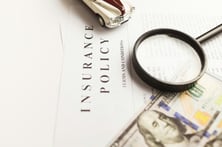 In simple terms, Trade Credit Insurance protects B2B companies or sellers of goods and services against bad debt, including insolvency, slow payment, and political risks. When these issues arise, they can be detrimental to a business. In fact, approximately 82% of bankruptcies are triggered by cash flow problems caused by issues like customer non-payment. In addition, accounts receivables typically represent more than 40% of a company's assets, and one in ten invoices becomes delinquent.
In simple terms, Trade Credit Insurance protects B2B companies or sellers of goods and services against bad debt, including insolvency, slow payment, and political risks. When these issues arise, they can be detrimental to a business. In fact, approximately 82% of bankruptcies are triggered by cash flow problems caused by issues like customer non-payment. In addition, accounts receivables typically represent more than 40% of a company's assets, and one in ten invoices becomes delinquent.
When should businesses consider Trade Credit Insurance?
Trade Credit Insurance applies to businesses of all sizes and in a variety of industries. Trusted Choice states that companies that sell goods and services on credit terms rather than requiring payment up front are exposed to the risk of nonpayment and should consider this coverage. In addition, companies that work with international exports have an increased risk and should take this insurance into account as well.
While there are alternatives to Trade Credit Insurance, they may not be the best option for businesses. According to James Daly, CEO and President of Euler Hermes, the main alternative is self-insurance, a practice many US organizations opt for. Businesses can put a reserve on their balance sheet to cover any bad debt that may occur over the year. However as Daly states, "rather than have capital in your balance sheet doing nothing but waiting for bad debt, why not purchase Trade Credit Insurance and then invest that excess capital into growth or new products?"
How can Trade Credit Insurance benefit your business?
Trade credit solutions can support sales growth while reducing trade risk and giving you the ability to:
- Avoid catastrophic bad debt losses
- Expand sales to new and existing customer with less risk
- Secure better borrowing terms with a lender
- Reduce bad debt reserves
- Enhance credit department efficiencies and results
The value of Trade Credit protection extends well beyond the insurance policy. A key benefit is the extensive financial database available from partners of R&R such as Euler-Hermes, the world's largest Trade Credit provider. The information available at their fingertips provides proactive notifications and protection from adverse financial issues that could be developing with your key business partners. In addition, their data is an excellent evaluation tool when making decisions on partnering or prospecting potential growth partners.
As a partner of premier trade credit insurers, R&R can assist your company with properly protecting its largest asset - accounts receivable. Contact a KnowledgeBroker for more information.
 Many employee benefits are subject to annual dollar limits that are periodically updated for inflation, such as HSAs, health FSAs, and transportation fringe benefit plans. This Compliance Overview includes a chart of the inflation-adjusted limits for 2019. Although some of the limits will remain the same, many of the limits increase for 2019.
Many employee benefits are subject to annual dollar limits that are periodically updated for inflation, such as HSAs, health FSAs, and transportation fringe benefit plans. This Compliance Overview includes a chart of the inflation-adjusted limits for 2019. Although some of the limits will remain the same, many of the limits increase for 2019.
 Effective October 16, 2018, OSHA launched a "Site-Specific Targeting (SST) inspection program". The goal of the program is to ensure that employers provide safe and healthful workplaces by directing enforcement resources to those workplaces with the highest rates of injuries and illness.
Effective October 16, 2018, OSHA launched a "Site-Specific Targeting (SST) inspection program". The goal of the program is to ensure that employers provide safe and healthful workplaces by directing enforcement resources to those workplaces with the highest rates of injuries and illness.  Whether we're ready for it or not, winter weather is upon us. And with colder temps comes an obvious increase in the use of fireplaces. For many of us, our fireplaces/chimneys haven't been touched in months. However, c
Whether we're ready for it or not, winter weather is upon us. And with colder temps comes an obvious increase in the use of fireplaces. For many of us, our fireplaces/chimneys haven't been touched in months. However, c
 Insurance needs are often overlooked for college kids in the hustle and bustle of preparing for college. It's not uncommon for college kids to have thousands of dollars of electronic equipment and a closet bursting with clothes in the dorm rooms, as well as bicycles and instruments.
Insurance needs are often overlooked for college kids in the hustle and bustle of preparing for college. It's not uncommon for college kids to have thousands of dollars of electronic equipment and a closet bursting with clothes in the dorm rooms, as well as bicycles and instruments. 80% of Homeowners Overlook Costly Water Leak Exposure When Heading on Vacation
80% of Homeowners Overlook Costly Water Leak Exposure When Heading on Vacation Summer in Wisconsin is filled with a wide range of temperatures, which can lead to severe storms. While many of us enjoy a good summer storm and the lightning show that comes along with it, we can't forget how dangerous they can be.
Summer in Wisconsin is filled with a wide range of temperatures, which can lead to severe storms. While many of us enjoy a good summer storm and the lightning show that comes along with it, we can't forget how dangerous they can be. Jason and Susan are a successful couple in their early 40’s, with two young children. They have two autos and a new home in Colgate, WI. They said they had a good relationship with their previous agent, however during a discussion with their wealth manager realized that they hadn’t had a coverage review in quite some time. During our initial 30 minute meeting at Jason’s office, we discovered some major coverage deficiencies: unfortunately a vehicle that had been traded in a few months ago and replaced with a newer vehicle was not accurately updated on their auto policy, leaving the vehicle uninsured. While that issue was quickly remedied, we also significantly reduced their risk exposure while decreasing their total premium 20% by rebalancing their program as follows:
Jason and Susan are a successful couple in their early 40’s, with two young children. They have two autos and a new home in Colgate, WI. They said they had a good relationship with their previous agent, however during a discussion with their wealth manager realized that they hadn’t had a coverage review in quite some time. During our initial 30 minute meeting at Jason’s office, we discovered some major coverage deficiencies: unfortunately a vehicle that had been traded in a few months ago and replaced with a newer vehicle was not accurately updated on their auto policy, leaving the vehicle uninsured. While that issue was quickly remedied, we also significantly reduced their risk exposure while decreasing their total premium 20% by rebalancing their program as follows:
